‘The Post’ is a must-see drama showcasing Meryl Streep, incredible set design, and strong messages for everybody
Steven Spielberg’s “The Post” is one of the best movies I’ve seen within the past year, primarily because of the deep messages and all-star acting. When I saw it for the first time, it immediately shot up the list of my favorite films, ranking among “Titanic” and “Harry Potter and the Sorcerer’s Stone” as some of my personal favorites. While the 117 minute production is very different from these famous flicks, it does contain much of the same deep conflict that makes those two movies so good. In this riveting PG-13 drama, Meryl Streep and Tom Hanks lead an all-star cast in demonstrating the importance of the freedom of the press and battling sexism, among facing other internal challenges.
“The Post” is set in the early ‘70s, with many plot elements circled around the Vietnam War. This may sound boring at first, a story centered on news, but I think that everybody can find something to relate to. Whether it be the blatant sexism that Katharine faces, or the internal struggles she has with her confidence, everybody can relate to her somehow.
Nominated for Best Picture and Best Actress at The Academy Awards, the movie covers events that led up to the release of some major government secrets, as Katharine Graham (Meryl Streep) and Ben Bradlee (Tom Hanks) work to expose the lies. Katharine is the current publisher of The Washington Post, a role she stepped into after her husband, the former publisher, passed away, while Ben is a high-ranking editor. When The New York Times breaks the news of a government cover-up that had been occurring for over 30 years, referred to as the Pentagon Papers, Katharine, Ben, and their team of hard-working writers work to expose the leaked information. When they have to stare the idea of jailment in the face, they are left to decide whether informing the world is worth risking their careers and freedom.
Every detail, from the pen in the secretary’s hand to the pajamas Katharine’s granddaughter wears, down to the carpeting in the newsroom fits the time period perfectly. All the clothes, sets, props, and even the food they eat, screams “classy 1971 in New York City.” Seeing Katharine’s elegant yet very professional clothes reminded me of pictures I’ve seen of my grandma on her way to job interviews when she was younger. The set design was impressive, not because of grand, beautiful rooms (although, that did help — I totally want Katharine’s dining room now) but because of the realness and the way it encapsulated the story. Watching the fluorescent lights reflect off the characters’ foreheads as they jostled the rickety water dispenser in the newsroom made me feel like I was actually there. I could almost smell the stale coffee and newsprint as the reporters rushed around the workroom reading and talking. I was very impressed at how the set actually created the tone of the movie and created an almost immersive experience so I felt like I was there with them.
When I was talking to my friend about this movie she said “Meryl Streep — no one else matters.” While Tom Hanks did deliver a great performance, it’s definitely not hard to see that she is the star of this film. She has played so many different roles, from her ice-queen boss lady character in “The Devil Wears Prada” to her spot-on interpretation of Julia Child in “Julia and Julia” to the eerie witch in “Into the Woods,” Meryl Streep is arguably one of the most versatile actresses of our time. She has embodied so many different types of roles, and each character is strikingly unique, so it can be hard to compare one character to the next. In “The Post,” Katharine Graham is unique in that she has so much power, yet doubts herself still. Which leads me to my next point…
“The Post” portrayed Katharine in the most feminist-empowering way possible. Besides the obvious advocacy for the freedom of the press, which the producers did incredibly as they represented these reporters as the real-life heros they are, the feminist messages buried beneath the surface empowered me in a way no film ever has. None of the men in the news industry believe that she can handle running a newspaper; she doesn’t even really believe it herself for most of the movie. While on Wall Street doing business on behalf of the company, she walks into a room of executives — doesn’t sound like a big deal at all, right? With the viewer’s perspective facing her back, Katharine opens an enormous set of old-looking doors to reveal a compact, bustling, smoky, crowded room of men. She is the only woman to be included at all. That scene left a huge impact on me; women just weren’t considered parts of that business, and the undeniable sexism could be seen so clearly. Later, as she is leaving a different meeting, she is walking down the steps of the Supreme Court as women of all different ages crowd on the same stairs. The admiring looks that all the little girls and women give her as she descends the stairs gave me goosebumps.
My favorite part however, is when she is talking to the other (male) company executives late one night about a major make-or-break decision for the company. As the publisher, she has the final choice and he thinks it over, eventually making her choice. The men around her doubt what she is thinking, and tell her to change what she picked. She looks around and says cooly, “My decision stands, and I am going to bed.” I could see the moment of realization and almost disbelief on the guys faces as she swept out of the room. I loved that part so much because she was just so strong and independent. The choice she made was the riskier one, too, and that’s why the guys thought she should change it. Hearing her say, essentially, “no, I’m not going to listen to this anymore” was just so awesome and empowering. That one, simple little sentence she spoke was the icing on the cake with this movie for me.
“The Post” is still showing in many theaters.
by ALAINA ROBERTS










